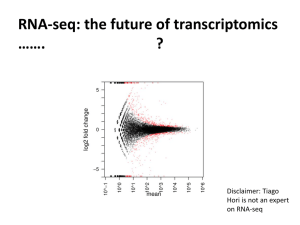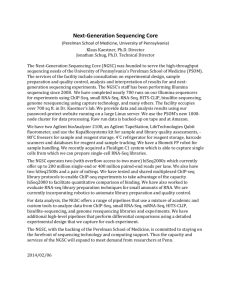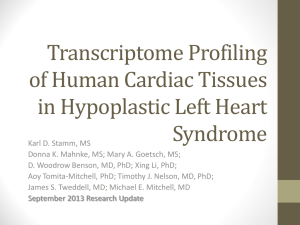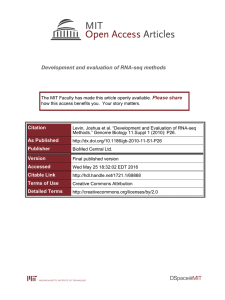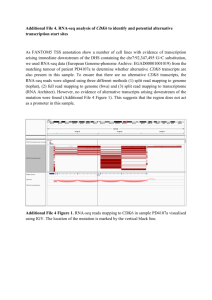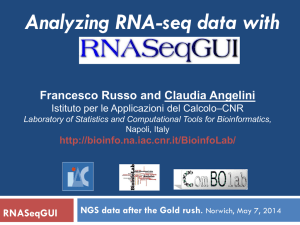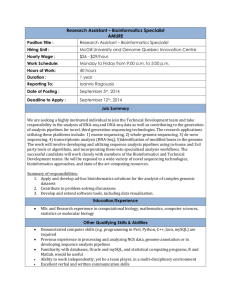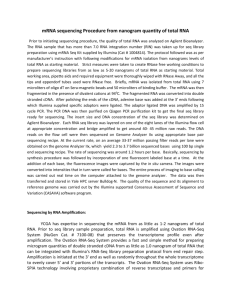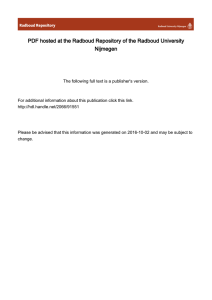PPTX - Department of Computer Science
advertisement
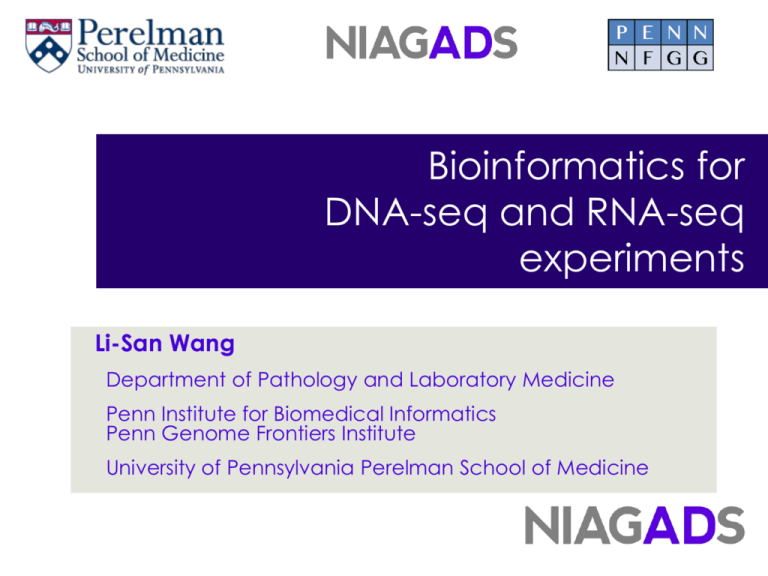
Bioinformatics for DNA-seq and RNA-seq experiments Li-San Wang Department of Pathology and Laboratory Medicine Penn Institute for Biomedical Informatics Penn Genome Frontiers Institute University of Pennsylvania Perelman School of Medicine Next Generation Sequencing Technology Generate reads of billions of short DNA sequences in the order of 100nts in a week Costs < $5K for resequencing a human genome Hi-Seq 2000: run 2 flow cells (300Gb each) in ~ 1 week, sequences 6 genomes Illumina Hi-Seq 2000 Applications of NGS DNA-Seq resequences genomes to identify variations associated with diseases and traits Use RNA-Seq to study gene expression activities Use ChIP-Seq and DNase-Seq to measure protein-DNA interactions and modifications … Many other types of protocols Central Dogma RNA-Seq Library prep RNA Images: illumina Reverse Transcription & DNA fragmentation Sequencing and Analysis High read heterogeneity along RNA transcripts Needs to dig deeper! Secondary structures Functional classes Modifications (non-standard nucleotides) Visualization … and many other questions SAVoR: RNA-seq visualization Fan Li, Paul Ryvkin, Micah Childress, Otto Valladares, Brian Gregory*, Li-San Wang*. SAVoR: a server for sequencing annotation and visualization of RNA structures. Nucleic Acids Research, 2012. HAMR: Detect RNA modification using RNA-seq Paul Ryvkin, Yuk Yee Leung, Micah Childress, Otto Valladares, Isabelle Dragomir, Brian Gregory*, and Li-San Wang*. HAMR: High throughput Annotation of Modified Ribonucleotides. RNA, in press, 2013. CoRAL: Use small RNA-seq to annotate non-coding RNA function classes Yuk Yee Leung, Paul Ryvkin, Lyle Ungar, Brian Gregory*, Li-San Wang*. CoRAL: Predicting non-coding RNAs from small RNA-sequencing data. Nucleic Acids Research, 2013. RNA-Seq-Fold: Use pairing-informative RNA-seq protocols to estimate secondary structures (in progress) CoRAL SAVoR: web-based visualization of RNAseq data in a structural context http://tesla.pcbi.upenn.edu/savor/ RNA-seq data + 2nd structure = SAVoR Plots ! Li et al., NAR 2012 Log-ratio of dsRNA-seq to ssRNA-seq read coverage along the At2g04390.1 transcript. Modified RNA – Motivation: Sites with unusual mismatch patterns in RNA-seq A 1 2 3 C 98 45 3.2 G 0.5 53 4.6 T 0.3 0.7 76.5 1.2 1.3 15.6 3a 1. A in actual sequence, C/G/T are due to 1% base calling error rate 2. A/C SNP, G/T are due to 1% error rate 3. G/T ratio too far away from 1:1, heterozygotes cannot explain a. A and C rates are too high for base calling error Observed nucleotide pattern at a known m2G site In an Alanine tRNA tRNA modifications guanosine (G) 1 2 H2 N 6 5 3 4 7 8 9 5' N-2-methylguanosine (m2G) 1 tRNA-modifying protein 2 6 5 3 4 7 8 9 5' 3' 2' 3' Watson-Crick pairing edge has been modified 2' Detecting modified RNAs: change in RT effects when Watson-Crick edge is modified Watson-Crick edge Statistical model for HAMR H01: homozygous reference, low base calling error H02: heterozygote, low base calling error In both cases, there should be at most two nucleotides with high frequencies ML ratio test Annotation: naïve Bayes model on non-reference allele frequencies Results Statistical analysis on known modification sites show this idea works with high specificity Known modifications predicted to affect RT Detected modifications predicted to affect RT Our data Yeast dataset Classification accuracy Train on human tRNA data, test on yeast tRNA data Precursor Classes Observations Accuracy A m1A|m1I|ms2i6A, i6A|t6A 187 98% G m1G, m2G|m22G 86 79% U D, Y 17 96% Modifications in other RNAs Scan the entire smRNA transcriptome for candidate modified sites * Uniquely mapped reads in 4 libraries * Removed sites corresponding to read-ends * Removed sites corresponding to known SNPs HAMR High-Throughput Annotation of Modified RNAs Ryvkin et al., RNA, 2013 http://tesla.pcbi.upenn.edu/hamr/ Please contact us if you are interested! RNA-seq is more than an expensive digital gene expression microarray NGS algorithms and experimental protocols should integrate tightly Bioinformatics scientists Bench scientists DNA-Seq: find genetic variations linked to traits and diseases All individuals have small differences between each other Single nucleotide polymorphism (SNP) is the most common form Other types: indel, copy number variation, rearrangement Genetic polymorphisms may lead to different phenotypes and diseases 21 trisomy: Down syndrome Substitution 1624G>T of the CFTR gene leads to change of amino acid (G542X) which leads to cystic fibrosis Alzheimer’s Disease Sequencing Project Announced in Feb. 2012 Participants NIA, NHGRI ADGC and CHARGE Large-Scale Genome Sequencing and Analysis Centers (Broad/Baylor/WashU) NACC (phenotype) and NCRAD (sample) NIAGADS (data coordinating center) NCBI dbGaP/SRA Design: 584 WGS / 11,000 WES (>300TB data) WGS data of 584 samples available from our ADSP data portal Visit ADSP website www.niagads.org/adsp to learn about study design, apply for data access, download data Photo from http://nihrecord.od.nih.gov/newsletters/2012/03_02_2012/story5.htm Computational Challenges to Analyzing DNA-Seq data Mapping between 100~1000 billion reads to the reference genome with good sensitivity Variant calling: call SNPs and structural variants reliably Association: Find susceptibility variants by association tests Interpretation: Interpret the effect of variants Data management: Query, store, and distribute 100TBs of data ~~ And that’s just for one project! Cloud computing using Amazon EC2 Can run hundreds of cores on Amazon EC2 easily Can share data and programs easily Very good security Steep learning curve Needs to provide pre-configured workflows/environments allows you to run analysis easily on Amazon Storing data is very expensive $0.1/GB-Month, or $1200/TB-year Glacier is 10 times cheaper but also that much slower DNA Resequencing Analysis Workflow (DRAW) BWA GATK Picard Samtools GATK GATK Samtools Easy to run – invoke phases by five commands, no need to mouse-click like crazy Memory request based on data size Support SunGridEngine for cluster computing Modular architecture, job monitoring, job dependency, auditing, error checking Runs on Amazon EC2, $582/FC We are migrating all our NGS pipelines to DRAW architecture NIA Genetics of Alzheimer’s Disease Data Storage Site (NIAGADS) Portal to AD genetics studies funded by NIA Portal for ADSP data Portal for other large-scale AD sequencing projects (>2,000 whole genomes, >400TB raw data) being developed Software (DRAW+SneakPeek) and other resources Signup for user account and news alert at www.niagads.org Lab members Chiao-Feng Lin Otto Valladares Tianyan Hu Mugdha Khaladkar Dan Laufer Fan Li Paul Ryvkin Fanny Leung Amanda Partch Micah Childress John Malamon Yih-Chi Hwang Mitchell Tang Alex Amlie-Wolf Pavel Kuksa Acknowledgements Schllenberg lab Gerard Schellenberg Pathology and Lab Medicine PSOM/CHOP Evan Geller David Roth Laura Cantwell Mingyao Li Maja Bucan John Hogenesch Chris Stoeckert Nancy Spinner Nancy Zhang Arupa Ganguly Dimitrios Monos Sampath Kannan Kate Nathanson Gregory Lab Jennifer Morrisette Lyle Ungar Alice Chen-Plotkin Brian Gregory Robert Daber Sarah Tishkoff Travis Unger Qi Zheng Laura Conlin Isabelle Dragomir Ellen Tsai Jamie Yang Avni Santani Sandeep Jain Zissimos Mourelatos CNDR/ADC Support: John Trojanowski Virginia Lee Vivianna Van Deerlin Steven Arnold Terry Schuck Robert Greene Penn Institute on Aging PGFI Alzheimer’s Foundation CurePSP foundation NIH: NIA/NIGMS/NIMH/NHGRI
